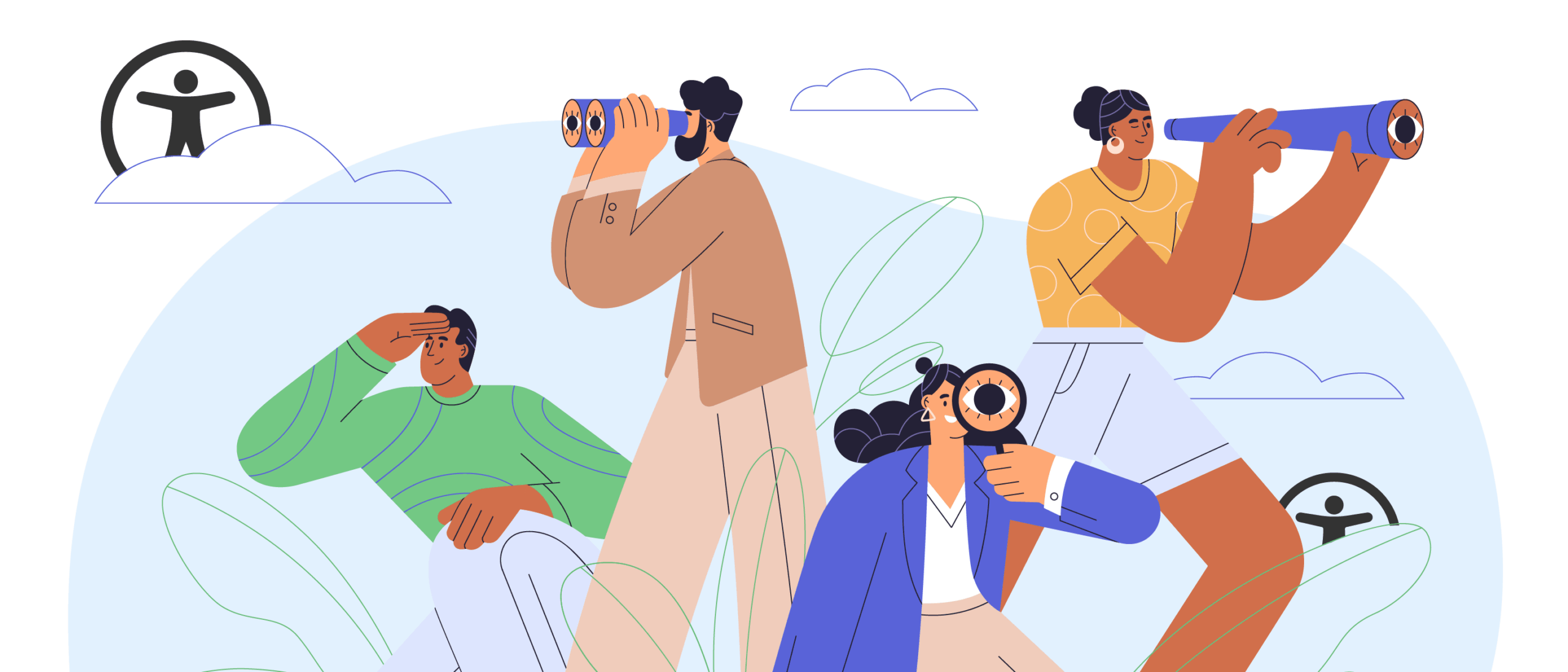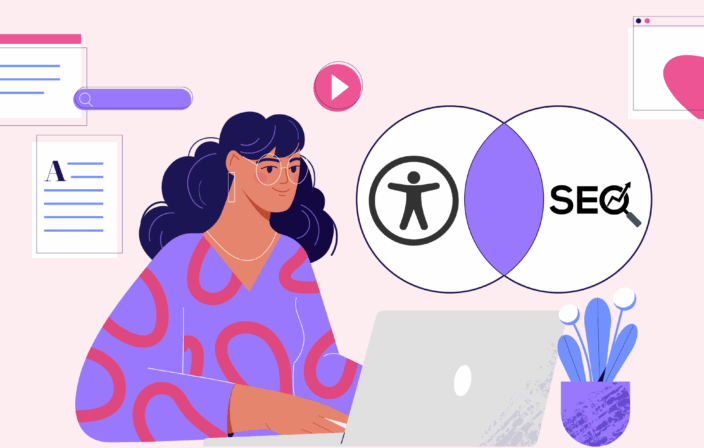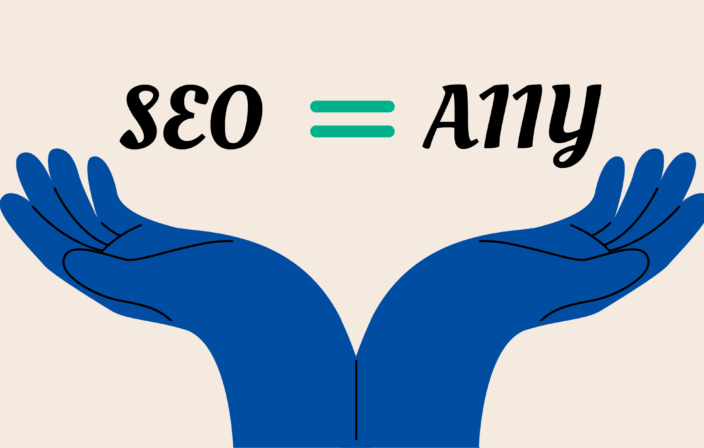In our previous articles, Patrick and I have talked (and talked, and talked) about how SEO and accessibility have mutual benefits, the symbiotic nature of these two disciplines, and how the main technology in each discipline works similarly. Most recently, we shared 7 foundational tactics that you should be employing to optimize your experiences.
We bring the series to a close with posts sharing where things are going, what you should do next, and offering some thoughts on voice technology. I will be writing from an accessibility-first perspective, and Patrick’s take will be SEO-first. Be sure to check out both articles as they use different examples!
Introduction
Using voice search while in the car or during our daily walks has become an integral part of keeping the peace in my family. It allows us to search for the “facts” needed to win debates and find useless trivia without having to break stride or risk mistyping as the roads jostle us from side to side. I mean seriously, who can be bothered to type anymore?!?!
Voice Technology: 250 years in the making
Scientists have been working with machines and voice since 1773. The BBC has published a fascinating hidden history feature called The machines that learned to listen. Some highlights that speak directly to voice recognition (pun intended) include:
- Bell Labs’ Audrey (Automatic Digit Recognition machine) recognized nine spoken numbers plus ‘yes’ and ‘no’ in 1952.
- Radio Research Labs in Tokyo worked on vowel detection in the 1960s.
- IBM’s Shoebox was showcased at the 1962 World Fair recognizing 16 English words.
- In 1971, Harpy by Darpa, the U.S. Department of Defense’s research agency, recognized full sentences based on a 1,011-word vocabulary; the vocabulary of an average three-year-old. This provided a new method of speech-to-text translation.
- IBM’s voice-activated typewriter named Tangora recognized 20,000 words.
- In 1997, Dragon Systems launched Dragon Naturally Speaking, the first continuous speech recognition product.
- Between 2007—2017, machine learning techniques were used to recognize voices with many different accents.
- Google Voice Search app for the iPhone changed the game. They were able to run large-scale data analysis on the huge number of human-speech examples they had amassed from billions of search queries.
- Google added personalized recognition to Voice Search on Android phones in 2010 and to its Chrome browser in mid-2011. Apple quickly offered Siri, its competing product, while Microsoft launched Cortana.
Voice search eliminates the time and effort required to type out the search parameters. It also opens a world of possibilities to those with mobility issues and those who find typing difficult.
Today’s automatic speech recognition systems (ASR) convert speech to text and use that as the search string. In doing so, however, the search becomes conversational. That usage change required even more technology to be built to be able to bridge the gap between structured and conversational language. These include technologies such as knowledge graphs and Google’s Hummingbird, which focuses on matching search context with the search results–a more natural fit to conversational queries.
Even as tech companies continue to build these new technologies, they still largely focus on the broadest segments of their user population. Consequently, they have built bias into their tools and technologies. Today’s speech recognition systems don’t always recognize the diversity of speech patterns often associated with disabilities such as Parkinson’s, cerebral palsy, Lou Gehrig’s disease, and Down syndrome.
Big tech companies have recently announced that they’re partnering with the University of Illinois to form the Speech Accessibility Project, whose goal is to upgrade AI’s understanding of people with disabilities and unusual speech patterns. The project is set to gather a set of high-quality, diverse speech samples that will help improve speech technologies.
We also see traditional voice technologies being upgraded to allow for more user types to interact with them, such as Amazon’s project Tap to Alexa which allows interaction without voice. The Alexa for Everyone team at Amazon worked directly with United Spinal Association members to gather feedback throughout the design and development cycle to ensure that it was built with the community in mind.
Digital Search Extends to the Physical World
The ability for blind and low-vision users to navigate complex ride service user journeys independently has been improving over the last several years. More accessibility features are now integrated into mobile apps and mobile phone technology as well. Even so, with all the unpredictable outside influences, technology isn’t always able to make the journey fully seamless–it sometimes comes up short.
Let’s say our blind user is visiting a city for the first time on a work trip. They search for and find an amazing eatery that they want to try, they book a car service with their mobile phone to take them there, but with city congestion, they are dropped off a little ways down the road. They are now stuck having to search for the restaurant’s entrance in an unfamiliar environment. With Door Detection, iPhone users will be able to navigate the last few feet to their destination.
According to Apple’s press release, Door Detection will be available later this year:
“Door Detection can help users locate a door upon arriving at a new destination, understand how far they are from it, and describe door attributes — including if it is open or closed, and when it’s closed, whether it can be opened by pushing, turning a knob, or pulling a handle. Door Detection can also read signs and symbols around the door, like the room number at an office, or the presence of an accessible entrance symbol. This new feature combines the power of LiDAR, camera, and on-device machine learning, and will be available on iPhone and iPad models with the LiDAR Scanner.”
Speaking of Mobile
Mobile-friendliness, which includes mobile accessibility, gets prioritized by Google’s algorithms. More disabled users are moving to smartphones. This technology enables them to consume accessible-rich applications, some applications dedicated to accessibility (which leverage embedded technologies like cameras or LiDAR as we see with Door Detection), and mobile-specific assistive technologies like VoiceOver and TalkBack. This trend truly represents cause and effect: as usage increases, so does the priority to make more widely consumable products available. In WebAim’s Screen Reader Survey #9, 39% of users report that Web content has become more accessible over the previous year.
Some other results of interest in this survey:
- 90% of respondents are using screen reader technology on mobile.
- 72% of respondents are iPhone users while 26% are using Android devices.
- With common online tasks like banking and shopping, the respondents’ smartphone usage splits between 52% using apps and 48% using a mobile website.
What Does the Future Hold for SEO and Accessibility?
Google continues to stress that accessibility does not have a direct impact on SEO. However, we know that it has a strong indirect impact through user experience measurements and a host of other factors. In Google Search Central SEO hangouts, like this one, the importance of accessibility has been openly discussed and they do not rule out the possibility of it becoming a ranking factor in the future. The holdup is currently limited to the ability to quantify accessibility.
The importance of good, accessible user experiences is expected to play an increasingly important role in Google’s Core Web Vitals as the capability of machine learning to measure user experience becomes more adept. The algorithms are expected to continually update to accurately reflect user interest. As more websites become more accessible, more and more users will be able to consume more digital properties.
What Should Your Brand Do Next?
Brands need to prioritize accessibility. Not only because it’s the right thing to do and influenced by regulation, but most importantly because a large segment of the global population is aging. In the near future, more and more people are likely to experience disabilities. These people will continue to interact with brands they love but their user expectations will change as their need for accessibility increases. Brands must be ready for the potential tidal wave on the horizon if they want to keep the customers they currently have, let alone grow their base.
As you pick up the accessibility mantle or optimize your program, there are two key things to keep front of mind:
- Do not forget to include the disabled community. Never concept, design, or test without their input; don’t assume that you know what they need or what works for their unique circumstances.
- Support your teams. Organizational change is hard. No one can solve every problem with a single twirl of the wand. But, accessibility-minded people can make very positive contributions that have constructive impacts individually, and add incrementally to the whole. They need your help and support to stay motivated, focused, and energized.
Closing
The topic of accessibility can seem daunting, but it needn’t be. Like any new skill, it takes time, practice, and perseverance. Approach the situation with an openness to learn and grow. No one expects you to get everything perfect on the first try…but your users do expect you to try— and to improve over time.
Take the first step, it does not matter which one. Things will start to snowball. Trust me, you’ll be surprised how quickly you can gain traction and improve over time. People want to do the right thing. You can grow exponentially when you find other champions within your digital teams and within your larger organization to combine forces and make a coordinated effort.
We hope you found this series on accessibility and SEO useful. If so, please be kind enough to share it with your friends, colleagues, and your network. Even better, take a moment to suggest the series be amplified by your favorite SEO newsletter.
About Sitebulb
Sitebulb is a website auditing and SEO tool that provides comprehensive crawl analysis and presents recommendations that guide your audit workflow with intuitive next steps, from investigation to reporting. In-depth explanations of every issue help you fully understand the results and have confidence in your recommendations, which makes Sitebulb a great fit for digital marketers who regularly need to do website audits.
Patrick Hathaway is a Director at Sitebulb, where most of his time is spent trying to help Sitebulb’s users to make best use of the wealth of data that the software uncovers. As part of this ongoing mission, he has written an entire library of ‘Learn More’ guides for the 300+ issues that Sitebulb flags, explaining both why a particular problem is worth your attention, and how to go about fixing it. Common feedback from digital agency owners is that this works as an extremely effective training ground for more junior recruits.




